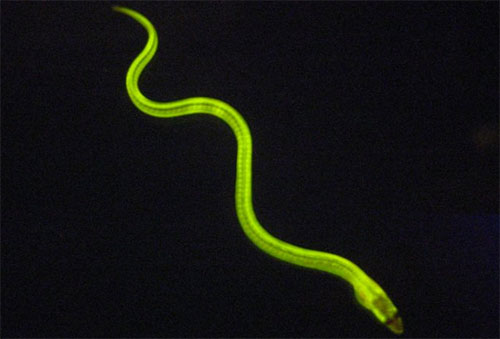This Japanese eel, known as Unagi, is the first fish — in fact the first vertebrate — found to be naturally fluorescent.
Most of us will have seen 'Glofish' and other fish that have been genetically modified to make them fluorescent. But the Unagi eel (Anguilla japonica) isn't one of them. It naturally harbours a fluorescent protein. It's also an endangered species and the discovery of the protein by researchers from the RIKEN Brain Science Institute may not only save human lives — but also contribute to the eel's conservation.
Best known as a culinary delicacy in Japan, Unagi and related species have seen a worldwide decrease in population, probably due to the effects of global warming, and Unagi is on the brink of extinction in Japan. Yet almost nothing is know about the biology of the eel.
Drs. Atsushi Miyawaki, Akiko Kumagai and their team cloned a gene from Unagi for an unusual fluorescent protein they named UnaG, for Unagi Green protein, that allows eels to glow in the dark. UnaG is the first fluorescent protein found in vertebrates; previously they were thought to exist only in simple animals like jellyfish.

But what makes UnaG truly unique in nature is that it needs a natural chemical to activate its powerful green light emission. In a surprise twist, the compound was identified by the authors to be bilirubin, a slippery molecule universally used in clinical labs around the world as a human blood marker for liver function.
Bilirubin is the breakdown product of blood haemoglobin and is toxic if present in excess in the body like in the characteristic yellow skin and eye colour conditions seen in newborn babies and jaundice. It is also a common marker in blood tests where bilirubin is used by doctors to assess liver function and for the assessment of health.
By analysing the structure of UnaG, the team discovered a novel mechanism of fluorescence enabling bilirubin to bind to UnaG and activate its light emission. With this property, they developed a superior new assay for bilirubin with high sensitivity, accuracy and speed that may become the global clinical standard, and can be used in developing countries where child liver health is a major issue.
Japanese freshwater eels have a long-distance migration life cycle, growing in inland rivers and swimming far into the sea to spawn. The authors identified UnaG and bilirubin in the muscle cells of Japanese, American, and European eels where they may aid in endurance swimming during migration. The unexpected discovery of UnaG may initiate legislation to conserve endangered eel species.


